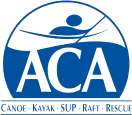by Gregg Berman
While many places still teach the rescued boat upside-down orientation, I prefer to teach the rescued boat upright orientation. While both methods have value, there are many reasons for my preference.
First, one of the hardest things for students as the rescuer is approaching and grabbing the overturned kayak. The bow is under the water, so you have to reach underneath to grab it. Many capsize at this point. Especially on boats with upswept bows this is even more an issue as they may be well below waterline. With the boat upright, you have a bow above the surface of the water, so no reaching below the waterline needed. It makes a much bigger and taller target to approach.
Once there, you only have the smooth slippery bottom of the overturned boat to hold on to. With the upright boat, you have toggles and deck lines to grab onto, making it easier to maintain that contact once you have it.
Next is the issue of getting the bow onto your deck. With proper hand placement and boat english it can be accomplished. Still we teach tricks like the using the coaming of the rescuer boat to scoop the bow of the overturned one. With the boat already rightside-up, the effect of rocker and upswept bows would in many boats place the bow over the edge of your cockpit without you doing anything. No need to pry it up via boat english nor brute strength.
While this may not be an issue with all boats, most prefer an upright orientation. Try either on land or in water placing one hand under you bow in the upright position and lifting just a few inches. The boat sits comfortably. Now try that same thing with the boat upside down. I'll bet with most boats if you only use one hand it's impossible without the boat trying to roll itself upright or at least onto it's side. Again this is more pronounced in boats with highly upswept bows, but it is true of almost any boat design from any sea kayaks, whitewater boats, surf boats and on.
Now we come to actually trying to pull the boat across your cockpit. The very thing that makes an overturned boat hard to hold onto, it's smooth, slippery, featureless bottom, now becomes an advantage as you pull it across your deck. The overturned boat has lines, bungee, compass, maybe spare paddles, deck bags and all many of other things in the way to get caught on or cause you to have to lift further. The upright boat has no such impediments.
Additionally the overturned boat has nothing on the surface closest to you (the hull) for you to grab onto as you pull. this necessitates reaching underneath where you will find something but you won't be able to see it. With the upright boat, you can immediately see what you have to work with and what is best to grab. and likely it will be in a better place to do so.
Now about the swimmer. The upside down position of the boat makes it harder for them as well. Many a swimmer has slipped off the back of the boat as they tried to assist by pushing down on the back of the wet smooth slick surface of their overturned boat to help lift it above the cockpit rim of their rescuer. This has and can lead to anything from a minor inconvenience to a long if not impossible (without additional help) separation between the swimmer and the rescuer with the two boats. The rightside-up presentation eliminates or reduces the need to press down and the stern, and even when doing so allows lots of options to hold on to. The only caveat here is to be careful with ruddered boats if trying to push down from the back end. But again the need is eliminated in most cases.
Without any effort I can pull a boat across my deck while upright even with the paddler still in it—no matter their size. While this has no practical use, I do it for my students just to demonstrate how easy and effortless the upright presentation makes it. The whole thing can be accomplished with much greater stability due to not having to reach under the waterline for that slippery overturned boat. It is much safer for the shoulders as it requires far less strength.
I have only ever heard two oppositions to this method from those that don't use it. One is that the upright boat will fill too quickly and the other one is that it takes more time as you have to turn the boat more than once. Well, neither of those is valid. No matter how big the seas, a boat is not likely to just fill up while sitting upright. If that were the case then why doesn't the boat fill between the time you upright it and the time the paddler reenters. As for taking more time—yes, it may be an additional five seconds to turn a boat that extra time, but given you have shaved time off acquiring the boat, getting the boat onto your deck and pulling it up, not to mention doing so with less effort and more stability, you have actually made the rescue faster for most.
Obviously, there is value in knowing as many rescues as possible, but since we are not pretending to teach everything that is out there but rather give students a base to jump off from, at least in my mind, all the above reasons make this method the one to introduce.
Back to Technical and Gear

